Aglaonema, also known as Chinese evergreen, is a popular houseplant known for its attractive foliage, but its popularity is largely down to how incredibly easy it is to grow! These plants are native to the tropical regions of Southeast Asia and come in a variety of colours and sizes, making them a great choice for any room.
In this ultimate growing guide, we will cover everything you need to know about how to grow Aglaonema in Australia, including its natural habitat, growth requirements, propagation, care, and a look at some of the most popular varieties.
More...
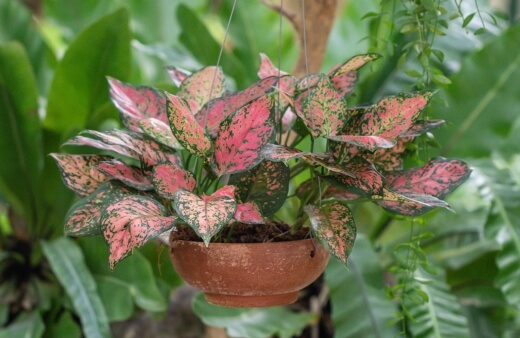
Family: | Araceae |
|---|---|
Genus: | Aglaonema |
Species: | Various |
Origin: | Subtropical Asia |
Common Names: | Chinese Evergreen |
Location: | Indoor |
Type: | Herbaceous perennial plant |
Growth: | 0.5-1m tall |
Sun requirements: | Bright, indirect light |
Foliage Colour: | Green, silver, pink, red, or variegated |
Flower Colour: | Small green-white flowers |
Flowering: | Usually in summer, unlikely indoors |
Edible Parts: | Small, red poisonous berries |
Maintenance level: | Low |
Poisonous for pets: | Yes |
What is Aglaonema?
Aglaonema is a genus of plants in the Araceae family that includes over 20 species. These plants are evergreen, herbaceous, and have attractive foliage that can range from green to variegated shades of white, pink, or even silver.
Chinese Evergreen's Natural Habitat
Aglaonema plants are native to tropical and subtropical regions of Southeast Asia, including the Philippines, Thailand, Indonesia, and Malaysia. They grow naturally in the understory of tropical forests and are adapted to low light conditions and high humidity, making them ideal for bathrooms, and even around ponds in warm, humid parts of the country.
24 Best Aglaonema Varieties to Grow in Australia
Aglaonema is a great indoor plant that is easy to grow and care for. It is known for its beautiful foliage and makes an excellent addition to any space.
1. Aglaonema 'Cutlass' Cutlass has a distinctive shape and a bright, green, and yellow variegated leaf. It grows up to 40 cm high and 30 cm wide and is easy to care for. Cutlass is one the most common Aglaonema varieties thanks to its relatively laid-back growing needs, and it can thrive in low-light conditions. | 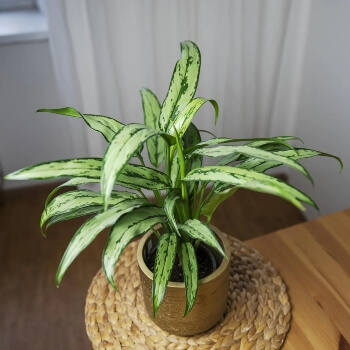 Source: DMP |
2. Aglaonema 'Black Lance' Black Lance has deep green leaves with silver markings, making it a striking addition to any room. It can grow up to 90 cm tall and 60 cm wide, and prefers moderate to bright indirect light. It's also known for its air-purifying properties. |  Source: GardenTags |
3. Aglaonema 'Silver Bay' A low-maintenance plant that can grow up to 1.2 m tall and 90 cm wide. The leaves of A. Silver Bay is a stunning silver-green colour with darker green edges. It prefers bright, indirect light and well-drained soil. This variety is also great for purifying the air in your home. | 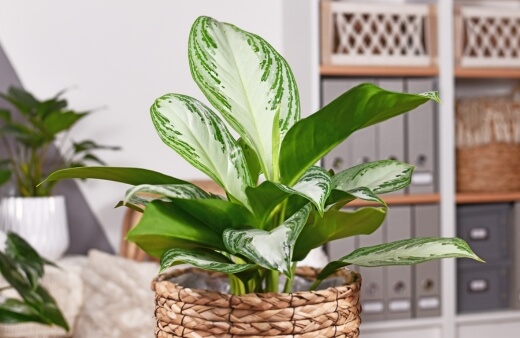 |
4. Aglaonema 'Emerald Beauty' With a height of up to 60 cm and a spread of 45 cm, Emerald Beauty has dark green leaves with white markings. It prefers low to medium light, making it a great choice for indoor spaces, and like most Agaonemas, it also has air-purifying properties. |  Source: PlantIn |
5. Aglaonema 'Crete’ This variety has dark green leaves with silvery-white scale-shaped markings. It grows up to 60 cm tall and 45 cm wide, and prefers bright, indirect light. It's also low maintenance and great for purifying the air in your home. | 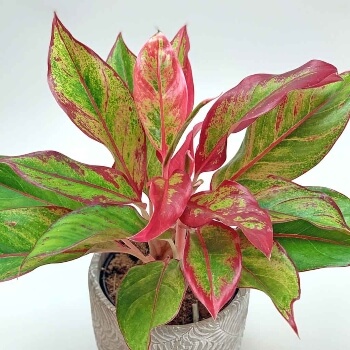 Source: Bloombox Club |
6. Aglaonema 'Maria' This plant has stunning green and silver variegated leaves that can grow up to 60 cm tall and 45 cm wide. It prefers low to medium light and well-drained soil, so bathrooms are fine, provided that they are reasonably well-ventilated. It's also great for improving indoor air quality. | 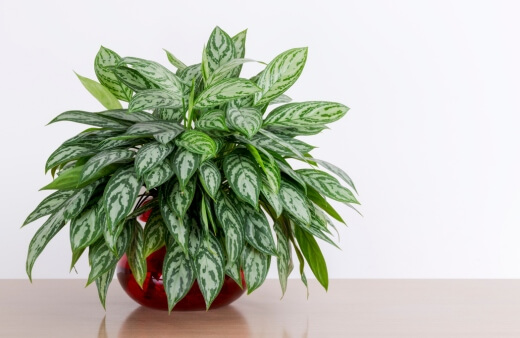 |
7. Aglaonema 'Red Siam' This variety has dark green leaves with bright red veins, making it a striking addition to any room. It can grow up to 1.2 m tall and 60 cm wide, and prefers bright, indirect light. It also has air-purifying properties. | 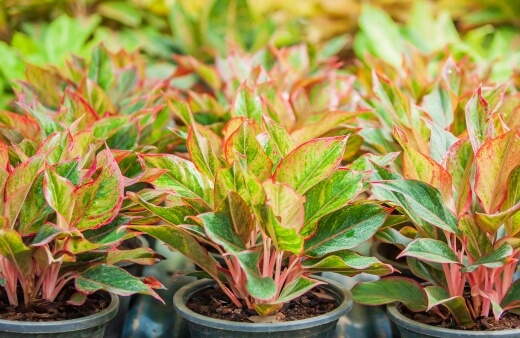 |
8. Aglaonema 'Silver Queen' This low-maintenance plant has dark green leaves with striking silver markings. It can grow up to 1.2 m tall and 90 cm wide, and prefers bright, indirect light. It's also known for its air-purifying properties. | 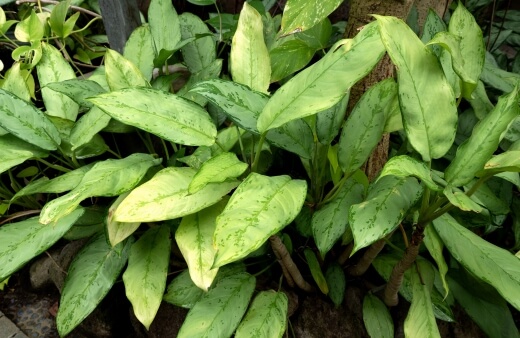 |
9. Aglaonema 'White Calcite' This variety has green and white variegated leaves that can grow up to 90 cm tall and 60 cm wide. It prefers bright but indirect light and well-drained soil, making it ideal for bedrooms, where humidity is generally normal and you can easily control moisture levels. It's also great for improving indoor air quality. |  Source: Planting Man |
10. Aglaonema 'Pink Dalmatian' Pink Dalmatian has unique, pink-spotted leaves and can grow up to 45 cm tall and 30 cm wide. It can cope with shade, but prefers medium to bright indirect light and well-drained soil. It's also low maintenance and great for purifying the air in your home. |  |
11. Aglaonema 'Golden Bay' This variety has green and gold variegated leaves that can grow up to 1.2 m tall and 90 cm wide. It prefers bright, indirect light and well-drained soil, so can be grown pretty anywhere in the house provided it's near a window, but away from direct afternoon sun. It's also known for its air-purifying properties. | 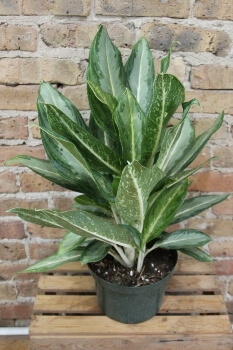 Source: Chicago Plants |
12. Aglaonema 'Emerald Star' Emerald Star has dark green leaves with silvery-white markings that can grow up to 60 cm tall and 45 cm wide. It prefers low light and a potting mix with good drainage. It's also great for improving indoor air quality. | 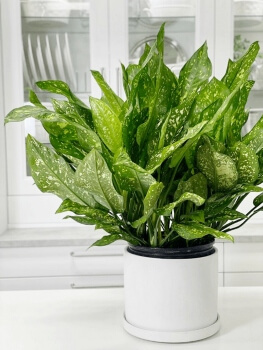 Source: nouveau raw |
13. Aglaonema 'Super White' Super White’s stunningly white leaves with green veins create a striking contrast that's hard to miss, making it popular with collectors. It's a smaller variety, growing to only about 30 cm in height, making it perfect for smaller spaces. | 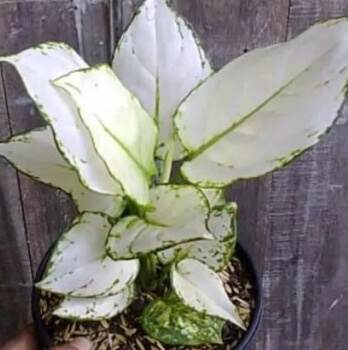 Source: Australian Plants Online |
14. Aglaonema 'Siam Aurora' Siam Aurora has luscious green leaves with distinctive bright pink veins, adding a splash of colour to any room. It can grow up to 75 cm tall so is a great choice for those looking for a larger Aglaonema variety to add structure to a room. | 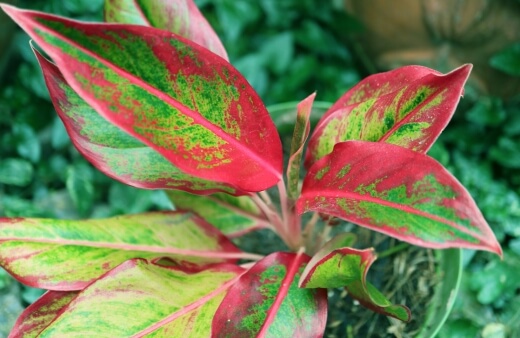 |
15. Aglaonema tricolour This stunning variety features broad, glossy leaves with bold green, silver, and pink markings. It's a relatively new cultivar that has quickly gained popularity among plant collectors, as so many of us are drawn to the elegant beauty of these variegated varieties of traditional plants. | 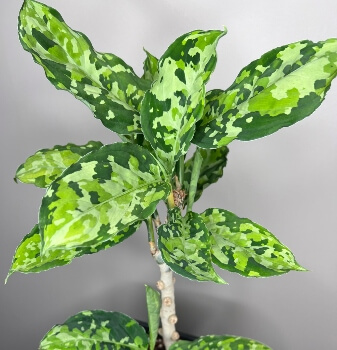 Source: Here But Not. |
16. Aglaonema 'Red Valentine' Red Valentine has deep green leaves with vibrant red-pink veins. It's a compact plant that can thrive in low light, making it perfect for those who want a low-maintenance indoor plant and need to brighten up shady south-facing rooms. | 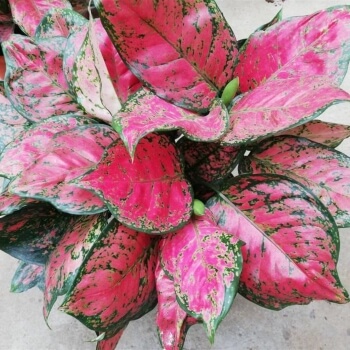 Source: paradisegroupnt.com.au |
17. Aglaonema 'Jubilee' With bright pink and green variegated leaves, Jubilee adds a pop of colour to any home. It grows up to 60 cm tall and prefers bright, indirect light so is great for tricky east or west-facing rooms. It is also a durable plant that can tolerate low light and drought, making it ideal for those of us without green thumbs. |  Source: Garden Goods Direct |
18. Aglaonema commutatum One of the most common species of Aglaonema is Aglaonema commutatum, also known as Chinese evergreen. This species has glossy, lance-shaped leaves that are usually dark green but can be slightly paler, with silver-grey markings. The leaves are arranged in a rosette pattern, forming a dense clump of foliage that can reach up to 60 cm in height. | 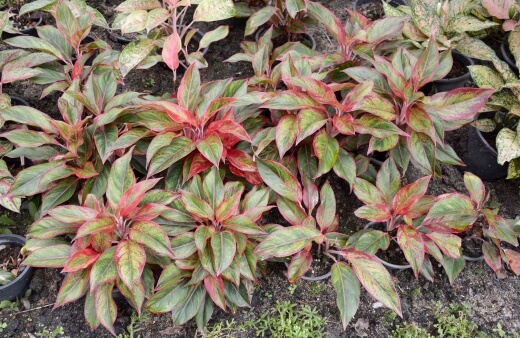 |
19. Aglaonema 'Emerald Holiday' This variety of Aglaonema has vibrant green leaves with gorgeous white veins. It is a slow-growing plant that can reach a height of 60 to 90 cm and a width of 30 to 60 cm. It is also known as the ‘Silver Queen’ and is a great choice for low-light areas. Its air-purifying qualities make it a popular choice for offices. | 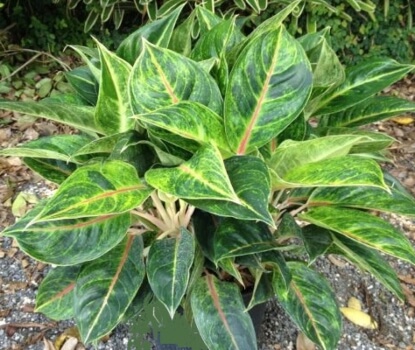 Source: Care of House Plants & Flowers House Plant Care |
20. Aglaonema 'Siam' Siam’s striking dark green leaves with bright pink veins make it a popular choice for houseplant growers. It grows up to 60 cm in height and prefers bright, indirect light. It is generally low maintenance. |  |
21. Aglaonema 'Sparkling Sarah' With bright, lime green leaves that are variegated with darker green streaks, Sparkling Sarah adds a talking point to any room. It can grow up to 60 cm tall and prefers bright, indirect light. |  Source: GardenTags |
22. Aglaonema 'Stardust' Stardust has broad, oval-shaped variegated leaves, with touches of silver and green. It can grow up to 60 cm in height and prefers bright, indirect light. It is also a durable plant that can tolerate low light and drought. |  Source: Luis Villanueva |
23. Aglaonema 'Stripes' This compact Aglaonema variety has narrow, pointed leaves that are variegated with shades of green and white. It can grow up to 30 cm in height and prefers moderate to bright, indirect light. | 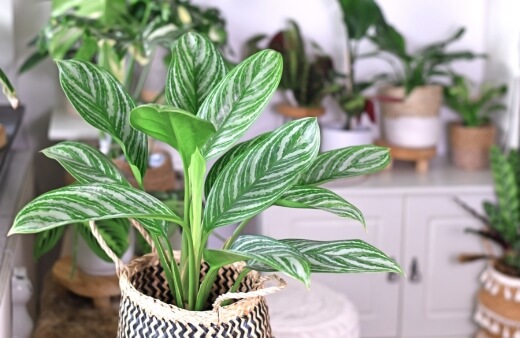 |
24. Aglaonema crispum Native to Southeast Asia, Aglanema crispum is a small to medium-sized herbaceous plant that typically grows up to 1 m tall. While most on this list will work best indoors, A. crispum is ideal for outdoor growers in warmer parts of the country with good humidity, or running water in the garden. Each leaf is dark green with a glossy texture and can grow up to 30 cm long and 12 cm wide. The leaf blades are oblong to elliptical with a pointed tip and have prominent veins running throughout. | 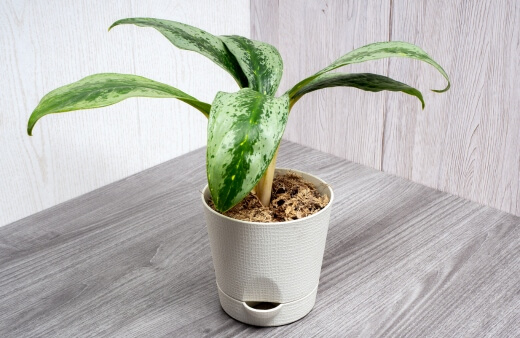 |
1. Aglaonema 'Cutlass'

Source: DMP
Cutlass has a distinctive shape and a bright, green, and yellow variegated leaf. It grows up to 40 cm high and 30 cm wide and is easy to care for. Cutlass is one the most common Aglaonema varieties thanks to its relatively laid-back growing needs, and it can thrive in low-light conditions.
2. Aglaonema 'Black Lance'

Source: GardenTags
Black Lance has deep green leaves with silver markings, making it a striking addition to any room. It can grow up to 90 cm tall and 60 cm wide, and prefers moderate to bright indirect light. It's also known for its air-purifying properties.
3. Aglaonema 'Silver Bay'

A low-maintenance plant that can grow up to 1.2 m tall and 90 cm wide. The leaves of A. Silver Bay is a stunning silver-green colour with darker green edges. It prefers bright, indirect light and well-drained soil. This variety is also great for purifying the air in your home.
4. Aglaonema 'Emerald Beauty'


Get Your Free Guide:
Master Growing Australian Natives eBook
A Must Have Complete Guide for Every Australian Garden
Get Your Free Guide:
Master Growing Australian Natives eBook
A Must Have Complete Guide for Every Australian Garden

Source: PlantIn
With a height of up to 60 cm and a spread of 45 cm, Emerald Beauty has dark green leaves with white markings. It prefers low to medium light, making it a great choice for indoor spaces, and like most Agaonemas, it also has air-purifying properties.
5. Aglaonema 'Crete'

Source: Bloombox Club
This variety has dark green leaves with silvery-white scale-shaped markings. It grows up to 60 cm tall and 45 cm wide, and prefers bright, indirect light. It's also low maintenance and great for purifying the air in your home.
6. Aglaonema 'Maria'

This plant has stunning green and silver variegated leaves that can grow up to 60 cm tall and 45 cm wide. It prefers low to medium light and well-drained soil, so bathrooms are fine, provided that they are reasonably well-ventilated. It's also great for improving indoor air quality.
7. Aglaonema 'Red Siam'

This variety has dark green leaves with bright red veins, making it a striking addition to any room. It can grow up to 1.2 m tall and 60 cm wide, and prefers bright, indirect light. It also has air-purifying properties.
8. Aglaonema 'Silver Queen'

This low-maintenance plant has dark green leaves with striking silver markings. It can grow up to 1.2 m tall and 90 cm wide, and prefers bright, indirect light. It's also known for its air-purifying properties.
9. Aglaonema 'White Calcite'

This variety has green and white variegated leaves that can grow up to 90 cm tall and 60 cm wide. It prefers bright but indirect light and well-drained soil, making it ideal for bedrooms, where humidity is generally normal and you can easily control moisture levels. It's also great for improving indoor air quality.
10. Aglaonema 'Pink Dalmatian'

This variety has green and gold variegated leaves that can grow up to 1.2 m tall and 90 cm wide. It prefers bright, indirect light and well-drained soil, so can be grown pretty anywhere in the house provided it's near a window, but away from direct afternoon sun. It's also known for its air-purifying properties.
11. Aglaonema 'Golden Bay'

Source: Chicago Plants
This variety has green and gold variegated leaves that can grow up to 1.2 m tall and 90 cm wide. It prefers bright, indirect light and well-drained soil, so can be grown pretty anywhere in the house provided it's near a window, but away from direct afternoon sun. It's also known for its air-purifying properties.
12. Aglaonema 'Emerald Star'

Source: nouveau raw
Emerald Star has dark green leaves with silvery-white markings that can grow up to 60 cm tall and 45 cm wide. It prefers low light and a potting mix with good drainage. It's also great for improving indoor air quality.
13. Aglaonema 'Super White'

Source: Australian Plants Online
Super White’s stunningly white leaves with green veins create a striking contrast that's hard to miss, making it popular with collectors. It's a smaller variety, growing to only about 30 cm in height, making it perfect for smaller spaces.
14. Aglaonema 'Siam Aurora'

Siam Aurora has luscious green leaves with distinctive bright pink veins, adding a splash of colour to any room. It can grow up to 75 cm tall so is a great choice for those looking for a larger Aglaonema variety to add structure to a room.
15. Aglaonema tricolour

Source: Here But Not
This stunning variety features broad, glossy leaves with bold green, silver, and pink markings. It's a relatively new cultivar that has quickly gained popularity among plant collectors, as so many of us are drawn to the elegant beauty of these variegated varieties of traditional plants.
16. Aglaonema 'Red Valentine'

Source: paradisegroupnt.com.au
Red Valentine has deep green leaves with vibrant red-pink veins. It's a compact plant that can thrive in low light, making it perfect for those who want a low-maintenance indoor plant and need to brighten up shady south-facing rooms.
17. Aglaonema 'Jubilee'

Source: Garden Goods Direct
With bright pink and green variegated leaves, Jubilee adds a pop of colour to any home. It grows up to 60 cm tall and prefers bright, indirect light so is great for tricky east or west-facing rooms. It is also a durable plant that can tolerate low light and drought, making it ideal for those of us without green thumbs.
18. Aglaonema commutatum

One of the most common species of Aglaonema is Aglaonema commutatum, also known as Chinese evergreen. This species has glossy, lance-shaped leaves that are usually dark green but can be slightly paler, with silver-grey markings.
The leaves are arranged in a rosette pattern, forming a dense clump of foliage that can reach up to 60 cm in height.
19. Aglaonema 'Emerald Holiday'
This variety of Aglaonema has vibrant green leaves with gorgeous white veins. It is a slow-growing plant that can reach a height of 60 to 90 cm and a width of 30 to 60 cm.
It is also known as the ‘Silver Queen’ and is a great choice for low-light areas. Its air-purifying qualities make it a popular choice for offices.
20. Aglaonema 'Siam'

Siam’s striking dark green leaves with bright pink veins make it a popular choice for houseplant growers. It grows up to 60 cm in height and prefers bright, indirect light. It is generally low maintenance.
21. Aglaonema 'Sparkling Sarah'

Source: GardenTags
With bright, lime green leaves that are variegated with darker green streaks, Sparkling Sarah adds a talking point to any room. It can grow up to 60 cm tall and prefers bright, indirect light.
22. Aglaonema 'Stardust'

Source: Luis Villanueva
Stardust has broad, oval-shaped variegated leaves, with touches of silver and green. It can grow up to 60 cm in height and prefers bright, indirect light. It is also a durable plant that can tolerate low light and drought.
23. Aglaonema 'Stripes'

This compact Aglaonema variety has narrow, pointed leaves that are variegated with shades of green and white. It can grow up to 30 cm in height and prefers moderate to bright, indirect light.
24. Aglaonema crispum

Native to Southeast Asia, Aglanema crispum is a small to medium-sized herbaceous plant that typically grows up to 1 m tall. While most on this list will work best indoors, A. crispum is ideal for outdoor growers in warmer parts of the country with good humidity, or running water in the garden.
Each leaf is dark green with a glossy texture and can grow up to 30 cm long and 12 cm wide. The leaf blades are oblong to elliptical with a pointed tip and have prominent veins running throughout.
How to Grow Aglaonema in Australia
Best Conditions for Chinese Evergreen
Aglaonema is relatively easy to grow and can thrive both indoors and outdoors in Australia. When planting Aglaonema, choose a well-drained pot or container that is slightly larger than the plant's root ball and add rocks to the base so that the drainage holes remain open.
The soil should be moist and well-drained, with a pH between 6.0 and 7.0. Add perlite or sand to the soil to improve drainage if needed.
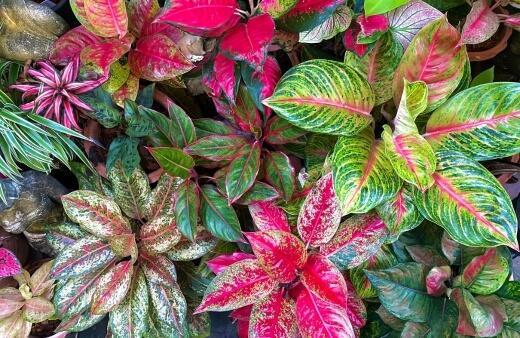
Soil & Drainage
Aglaonema plants prefer well-drained, nutrient-rich soil. Use a peat-free potting mix that is designed for indoor plants, regardless of where you plant it. The soil should be kept moist but not waterlogged, as overly wet soil can lead to root rot.
Water Requirements
Aglaonemas require moderate watering, and the soil should be kept consistently moist but not waterlogged. Water the plant thoroughly when the top inch of soil feels dry to the touch. During the winter months, stop watering entirely unless the soil completely dries out.
Light & Temperature
Aglaonema prefers low to medium light conditions and can be placed in shaded areas or rooms with indirect light. Too much direct sunlight can damage their leaves, so avoid placing them in north-facing windows.
Aglaonema plants can tolerate a range of temperatures but prefer temperatures between 18-27°C.
Propagating Aglaonema
Aglaonema plants can be propagated through seeds or cuttings, but while Aglaonema can be propagated through seeds, they take a very long time to germinate and can be difficult to find.
To grow your own at home, we’d strongly advise starting from cuttings to reduce time and produce healthier plants.
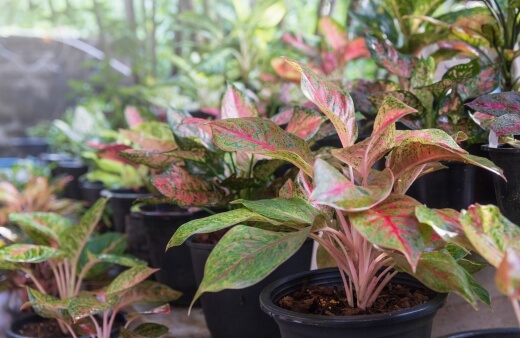
Propagating Aglaonema from Cuttings
The easiest and most common method of propagating Aglaonema is stem cuttings. Please, it's incredibly easy to do!
- Take a 10-20 cm stem cutting with a few leaves attached.
- Dip the cut end in a rooting hormone.
- Plant the cutting in moist soil and keep it in a warm, bright spot with high humidity.
- The cutting should root within a few weeks.
- Once rooted, plant into a slightly larger pot and treat it like any other Aglaonema.
Caring for Aglaonema
Aglaonema is a low-maintenance plant that requires very little attention. However, low maintenance doesn't mean no maintenance, so check out our tips below to keep your Aglaonema happy and healthy.
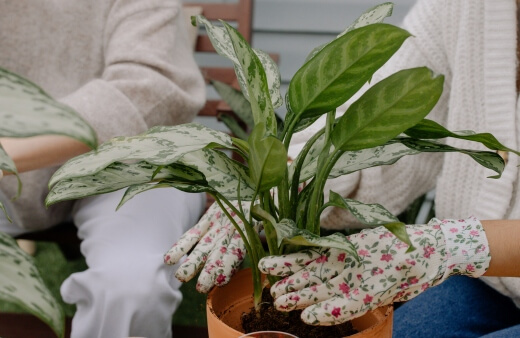
What Fertiliser to Use
Fertilising your Aglaonema is essential to keep it healthy and promote growth. It is best to fertilise your plant during the growing season, which is from spring to summer, and stop feed and fertiliser when active growth stops in late autumn.
Choose a balanced liquid feed - we use Baby Bio, but any foliage-focussed house plant feed will do. Feed your Aglaonema plant once a month during the growing season, and avoid fertilising through winter when the plant is dormant.
Pruning
Pruning is an essential aspect of maintaining the health and appearance of your Aglaonema plant. The plant can grow quite tall and leggy, and the lower leaves may start to yellow and drop, leaving you with bare stems, and a leafy top (particularly in dry and overly bright conditions).
It is essential to remove these yellow leaves regularly to keep the plant looking healthy and to prevent any potential diseases from spreading. To prune your Aglaonema, use clean and sharp pruning shears or scissors.
Cut back any yellow or brown leaves as close to the stem as possible. Be careful not to damage any healthy leaves or stems while pruning.
Repotting Aglaonema
Repotting your Aglaonema is essential for its overall health. Aglaonema plants prefer to be slightly root-bound though, so repotting every three years is more than enough. To repot your Aglaonema, choose a pot that is about 2” wider than its current pot.
Fill the pot with fresh, well-drained compost, mixed with perlite or grit, leaving enough room for the root ball. Gently remove the plant from its old pot, and tease out the outer roots.
Place the plant in the new pot and fill in the space around the roots with the potting mix. Gently tap the pot on the table to remove air pockets, and fill in any empty gaps.
After repotting, give your Aglaonema plant generous water and place it in bright, indirect light. It may take a few days for the plant to recover from the repotting process, so be patient and wait for a week or so before watering, or disturbing the roots again.
Aglaonema Pests and Diseases
Spider mites
These tiny pests can cause yellowing and speckling of the leaves. To control spider mites, spray your plant with a strong jet of water to dislodge them, or use an insecticidal soap.
Mealybugs
Mealybugs are small, white, cotton-like pests that feed on sap. They can cause yellowing and curling of the leaves. To control mealybugs, use a cotton swab dipped in rubbing alcohol to wipe them off the plant, but rinse any residual alcohol off leaves afterward.
Scale insects
These pests appear as small, raised bumps on the leaves and stems of the plant. They can cause yellowing and wilting of the leaves. To control scale insects, use an insecticidal soap or horticultural oil.
Root rot
Root rot is a general term for a wide range of fungal diseases, but all are largely caused by overwatering or poor drainage. It can cause the plant's roots to rot, leading to wilting and yellowing of the leaves. To prevent root rot, make sure to use well-draining soil and avoid overwatering.
Leaf spot
This fungal disease appears as brown or black spots on the leaves of Aglaonema. It can be caused by overwatering, poor air circulation, or high humidity. To prevent leaf spot, make sure to avoid overwatering, provide adequate air circulation, and avoid misting the leaves.
Aglaonema Frequently Asked Questions
Can Aglaonema grow in low light?
Aglaonema can tolerate low light conditions, making it an ideal plant for indoor growing. However, the plant will grow best in bright, indirect light, so avoid full shade, and stick to bright rooms, either on the north, east, or west-facing sides of the house.
How often should I fertilise my Aglaonema?
You should fertilise your Aglaonema once a month during spring and summer, and feed in autumn if there is still active growth. Use a balanced, water-soluble fertiliser and dilute it to half-strength.
How do I know if my Aglaonema needs to be repotted?
You should repot your Aglaonema every three years, or when the plant outgrows its current container. Signs that your plant needs to be repotted include roots coming out of the drainage holes, yellowing leaves, and a general lack of growth.
Wrapping Up Our Aglaonema Guide
Aglaonema is a beautiful and low-maintenance plant that can add a touch of elegance to any indoor space in Australia. With its wide variety of colours and patterns, there is an Aglaonema plant for every gardener.
Remember to provide the right soil, light, and water requirements, propagate carefully, fertilise regularly, and repot and prune as needed. With a little bit of attention, you can make any Aglaonema variety work well in most parts of the house.
Published on May 10, 2023 by Maisie Blevins
Last Updated on February 23, 2024




